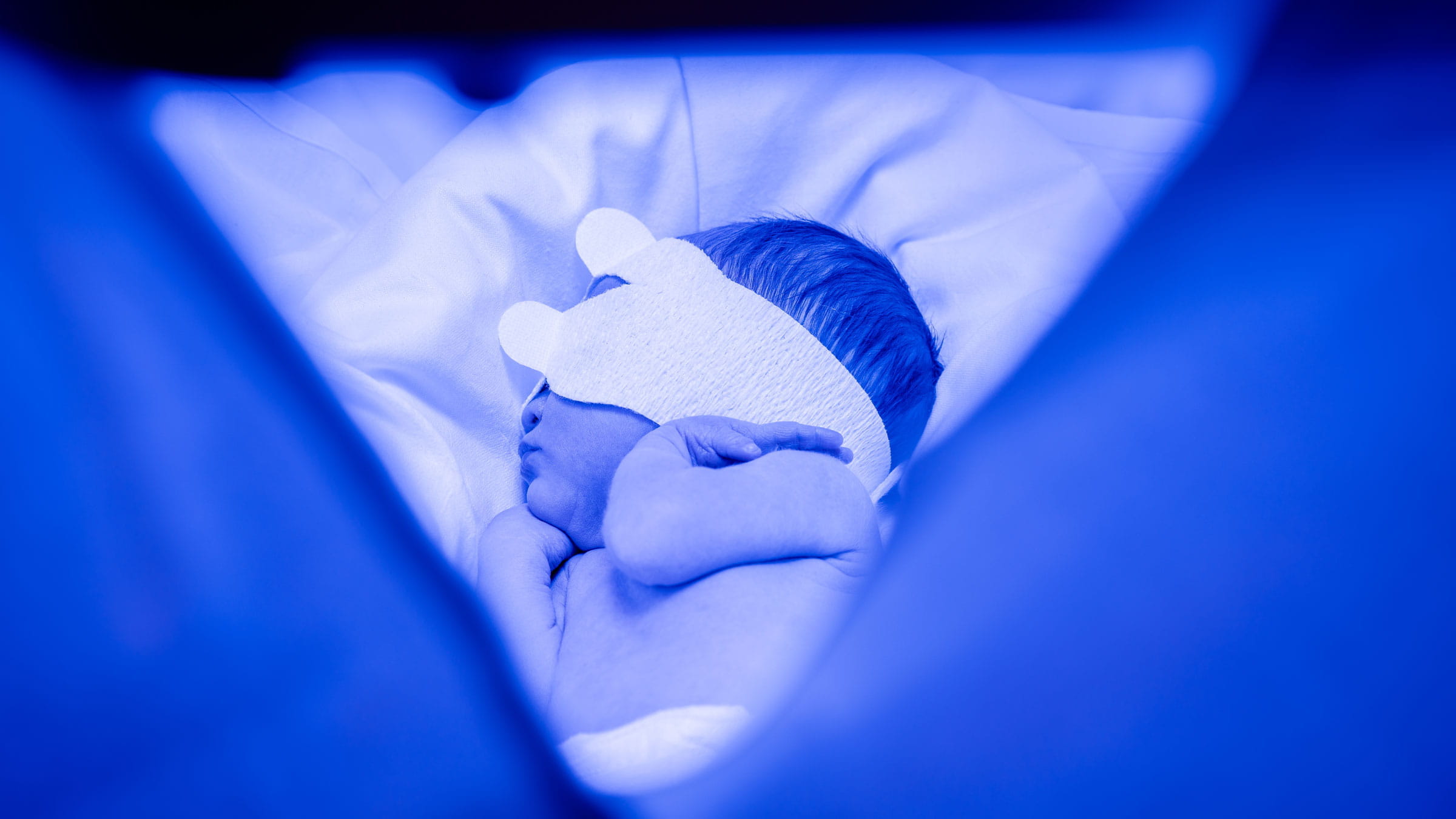How to get rid of jaundice in babies, and what to know if you’re expecting
Phototherapy can effectively lower bilirubin in most babies, but there are certain things to be aware of with jaundice.
Most newborns develop jaundice — about 60% of full-term babies and 80% of preterm babies develop it in the first week after birth. That’s why it’s helpful for new parents to know what to expect when it comes to diagnosing the condition and treating it in the hospital or at home, and how jaundice can become serious if left untreated.
Carrie Cacioppo, MD, medical director of the newborn nursery at The Ohio State University Wexner Medical Center and a pediatrician at Nationwide Children’s Hospital, answers families’ most common questions about bilirubin and jaundice below.
- Question What are bilirubin and jaundice in babies?
-
Answer
Higher levels of bilirubin and jaundice are normal in newborn babies. Bilirubin is the accumulation of a breakdown product in the baby’s blood, and jaundice is what happens when that bilirubin level is elevated (hyperbilirubinemia) and the baby’s skin and eyes look yellow.
- Question Why do babies develop high levels of bilirubin?
- Answer
- Question When do jaundice or high bilirubin levels need treatment in babies?
-
Answer
Jaundice needs to be treated if bilirubin levels get too high in baby’s blood. When the level is too high, it can cause harm in the baby’s eyes and brain and deposit into their skin. If jaundice isn’t treated and bilirubin is too high for too long, it can cause a disease called kernicterus, causing brain damage and potentially leading to intellectual disabilities, vision problems, cerebral palsy or hearing loss.
- Question How do we measure bilirubin or jaundice?
-
Answer
In the hospital, we continually monitor babies for jaundice starting with their first day of life. We try to catch any signs of jaundice first through a skin check using a noninvasive, painless transcutaneous meter that can measure yellowness of skin of the chest or forehead.
If the bilirubin level is high, then we’ll check the baby through their blood, using a heel stick and collecting a couple of drops of blood.
- Question Are certain babies more at risk for jaundice?
-
Answer
Some newborns are more likely to develop high bilirubin levels and jaundice. These include babies who…
- are born early (preterm and late-preterm babies, born earlier than 37 weeks)
- aren’t feeding well, especially exclusively breastfed babies
- have different blood types than their birthing parent
- are born to families with genetic blood disorders, such as G6PD deficiency
- have families with a history of newborn jaundice
- Question How is jaundice treated? What is phototherapy for jaundice?
-
Answer
If a baby isn’t efficiently removing bilirubin from their blood naturally, we can help them with special lights called “bili lights.” This phototherapy is a blue light that’s safe for babies and doesn’t include ultraviolet light. Bili lights help babies convert bilirubin to a more easily excretable form so that they can get rid of the chemical in their urine or stool.
We try to catch jaundice when the baby is still in the hospital, but sometimes jaundice will show up after they’ve been discharged, or occasionally a baby’s bilirubin level will bounce back and be too high again after going home. In this case, they can be treated with phototherapy at home.
If the baby is treated in the hospital, we use both an overhead phototherapy light and a “bili blanket” that emits light from underneath the baby. The blanket goes into their bassinet, and the overhead light goes over their bassinet in the postpartum room, so that they can stay with their family during treatment.
If the baby is being treated at home, they can use just the bili blanket. The treatment still works without the overhead light, but a bili blanket alone just isn’t quite as strong.
Babies still need to eat well to excrete that bilirubin, but the phototherapy helps that bilirubin break down more easily.
- Question How long does phototherapy take to treat jaundice to safe levels of bilirubin?
-
Answer
Newborn jaundice usually can be treated to a safe level within 24 hours, though there are some babies who continue to produce more bilirubin and need a few extra days.
Babies undergoing phototherapy at home might take longer to reduce their bilirubin levels. They’ll also be monitored by their pediatrician closely in those first four to five days, because jaundice can continue to rise. If the bilirubin levels aren’t reducing appropriately through home phototherapy, a baby might need to be readmitted to the hospital for treatment.
- Question Is phototherapy uncomfortable for babies?
-
Answer
Babies can be uncomfortable under bili lights, but it’s not the phototherapy lights that are making them uncomfortable. Babies like to be swaddled and held, but we need them to have their skin exposed to the phototherapy lights in order to receive treatment. However, we do our best to comfort them.
Some things that help them feel more comfortable is arranging blankets in certain ways or using specific swaddling techniques with help from the baby’s care team. You can also take the baby out from under the lights for about 20-30 minutes every three hours for skin-to-skin contact and for feeding.
Babies also wear soft goggles while under the bili lights. This is to help reduce any strain or discomfort for babies, since the lights are bright and these babies have been in a dark environment until recently. If the goggles slide off, the light won’t cause damage to their eyes.
- Question If a baby was diagnosed with hyperbilirubinemia or jaundice in the hospital, what happens after they go home?
-
Answer
After taking baby home, parents should track:
- Feeding habits
- Diaper habits (how many wet and dirty diapers, and color and consistency of stool)
- Yellowness of baby’s skin
As the baby starts making green and yellow stools, we know that they’re starting to convert and excrete bilirubin naturally on their own. If the baby is still having dark, sticky stools, then that yellow jaundice isn’t being excreted properly, and they should be checked by their doctor.
We recommend that all babies have a pediatrician checkup within the first two to three days after leaving the hospital. If the baby has undergone phototherapy in the hospital, their care team might recommend an appointment be made sooner so that their pediatrician can keep a closer eye on bilirubin and make sure the level doesn’t bounce back.
Typically, though, that first checkup is to check weight and jaundice level, making sure they’re eating well and producing plenty of wet and dirty diapers.
At home, parents should watch for yellowing in their baby’s skin. That yellowing typically starts from baby’s head and progresses to their belly and downward. If you notice yellow over the baby’s entire body, that can indicate a dangerous level of jaundice.
If baby has a darker skin tone, you can press on their skin for a few seconds to see if it’s yellow-tinged, or you can check the whites of their eyes for yellowness.
Noticing increasing yellowness or yellowness that isn’t going away is reason to visit the pediatrician for a bilirubin check. Most pediatricians’ offices are able to check for jaundice at the office, but if not, they’ll arrange for you to get it checked at a lab if necessary.
- Question Will taking the baby outside in the sun help reduce bilirubin and jaundice?
-
Answer
Many parents ask if putting their baby in the sun is enough treatment for jaundice. We don’t recommend that a baby be put directly in the sun, because it has ultraviolet rays that can damage a baby’s skin.
It can be helpful, though, to have baby near a sunny window — most windows have some protection from UV rays and provide some indirect light. However, this isn’t anywhere near as effective or as safe as blue-light phototherapy from bili lights or a bili blanket.

Join the family of Buckeye Babies
Learn about obstetrics and gynecology services from central Ohio's most experienced team.
Get started








